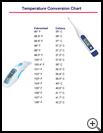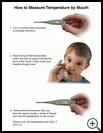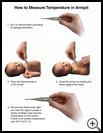
Vital Signs
________________________________________________________________________
KEY POINTS
- Vital signs are measurements of body temperature, heart rate, breathing rate, and blood pressure. Checking your child’s vital signs can alert you to health problems. When your child is sick, they are used to help check how your child is doing.
- Buy a good quality, digital thermometer. That way, when your child is sick, you can check whether your child has a fever.
- Check your child’s heart rate (pulse) if your child is ill, has a fever, or feels his or her heart is racing. If you don't know how to check your child’s pulse, ask your child’s healthcare provider to teach you.
________________________________________________________________________
What are vital signs?
Vital signs are measurements of body temperature, heart rate, breathing rate, and blood pressure. Vital signs give information about your child’s general health. They offer clues to medical conditions. When your child is sick, they are used to help check how your child is doing.
Temperature
Body temperature is measured with a thermometer. There are many types of thermometers that can measure your child’s body temperature in the mouth, ear, armpit, rectum, or on the forehead. It is normal for a temperature to be a little higher or lower depending on if you take it in your child’s mouth or take it in your child’s ear, armpit, forehead, or rectum. Taking a forehead temperature is easy and accurate for infants and for older children.
Body temperature can change because of:
- Time of day (normally lower in the morning than it is later in the day)
- Being stressed or dehydrated (not enough fluid in the body)
- Drinking hot or cold fluids or sitting in a cold room
- Thyroid problems
- Infections
- Being active such as running or walking quickly
- The age of the child
Normal body temperature for children and teens ranges from 97°F (36°C) to 99.9°F (37.7°C). In the first month of life, newborns may have a normal temperature range of 99.5°F (37.5°C) to 100.3°F (37.9°C) measured in the rectum. Infants may be very ill without having a fever.
Heart Rate
Your child’s heart rate is the number of times your child’s heart beats in a minute. It is also called a pulse. The pulse is usually easiest to feel at the wrist or at the neck.
Age Awake Heart Rate Sleeping Heart Rate --------------------------------------------------------- Newborn 100 to 180 80 to 160 1 to 12 months 100 to 160 75 to 160 1 to 2 years 80 to 110 60 to 90 3 to 5 years 70 to 110 60 to 90 6 to 12 years 65 to 110 60 to 90 13 to 17 years 60 to 90 50 to 90 ---------------------------------------------------------
Pulse rates can change because of:
- Infections
- Anxiety, stress, excitement, or anger
- Medicines, supplements, or caffeine
- Physical activity or rest
- Pain
- Thyroid problems
- Some heart problems
- Anemia (a low level of red blood cells)
Your child’s heartbeat should be regular, without any missed beats or extra beats. If your child has lost a lot of blood or is very sick, your child may have a fast, weak pulse that is hard to feel. Hearts that are working very hard may produce an unusually strong heartbeat.
Breathing Rate
Your child’s breathing rate is the number of times your child breathes in during a minute. It’s also called a respiratory rate. Your child’s rate of breathing can vary widely during the day. Breathing is usually a bit slower during sleep. The best time to check the breathing rate is when your child is resting.
Age Breathing Rate --------------------------------------------- Newborn 30 to 60 1 to 12 months 30 to 60 1 to 2 years 24 to 40 3 to 5 years 22 to 34 6 to 12 years 18 to 30 13 to 17 years 12 to 16 ---------------------------------------------
Breathing rates can change because of:
- Physical activity or rest
- Anxiety, stress, excitement, or anger
- Laughter
- Lung infections or coughing
- Surgery
- Narcotics
Breathing that is unusually slow or fast can be a sign of a serious problem.
Blood Pressure
Blood pressure is usually given as two numbers, such as 90/60. The first, upper number is the pressure when the heart beats and pushes blood out to the rest of the body. The second, lower number is the pressure when the heart rests between beats. Blood pressure can rise and fall with physical activity, rest, or emotions.
Blood pressure measurement in children is different than in adults. Normal blood pressure is based on your child’s age, gender, and height. Your child’s healthcare provider will check your child’s blood pressure during checkups after age 3. The provider will advise you if your child’s blood pressure is normal, or if it is higher than it should be.
High blood pressure makes it more likely that your child will develop problems in adulthood such as hardening of the arteries, heart failure, or a stroke.
Oxygen Level
If your child has your child’s vital signs checked in your child’s healthcare provider’s office, your child may have your child’s blood oxygen level checked with a sensor attached to your child’s finger or earlobe.
Should I check my child’s vital signs?
Checking your child’s vital signs can alert you to health problems. Here are some examples of things you can do:
- Buy a good quality digital thermometer, either a forehead or a mouth thermometer. That way, when your child is sick, you can check a temperature in case your child has a fever.
- Check your child’s heart rate if your child is ill, has a fever, or feels his or her heart is racing. If you don't know how to check your child’s pulse, ask your child’s healthcare provider to teach you.
- Talk with your child’s healthcare provider about what your child’s blood pressure is and what it should be. One high blood pressure reading may be caused by an error with the machine or feeling nervous at the healthcare provider's office. Several high readings over several hours or days may be a sign of a problem. Keep track every time your child’s blood pressure is taken. Note the date, time, BP reading, where it was taken, such as at home or at a clinic or in a store, and how it was taken. Talk to your child’s healthcare provider about how to lower your child’s blood pressure if it is too high.
- You usually do not need to check your child’s breathing rate unless your child’s healthcare provider tells you to do so.
Last modified: 2020-01-06
Last reviewed: 2019-12-23



